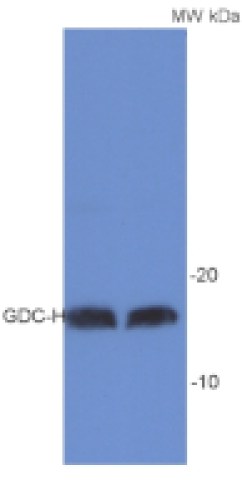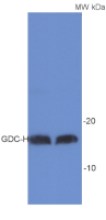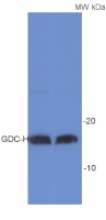
Anti-GDC-H | H protein of glycine decarboxylase complex (GDC)
(Cat#: AS05 074)


Description
- Immunogen: purified GDC-H protein from Spinacia oleracea
- Host: Rabbit
- Clonality: Polyclonal
- Purity: Total IgG. Protein G purified in PBS pH 7.4.
- Format: Lyophilized
- Quantity: 200 µg
- Reconstitution: For reconstitution add 200 µl of sterile water
- Storage: Store lyophilized/reconstituted at -20°C; once reconstituted make aliquots to avoid repeated freeze-thaw cycles. Please remember to spin the tubes briefly prior to opening them to avoid any losses that might occur from material adhering to the cap or sides of the tube.
- Tested applications: Tissue printing (TP), Western blot (WB)
- Recommended dilutions: 1 : 5 000 (TP), (WB)
- Expected | apparent MW: 16 kDa
- Confirmed reactivity: Arabidopsis thaliana, Cyanthobasis fruticulosa, Petrosimonia nigdeensis, Petunia hybrida cv. Mitchell, Portulaca grandiflora, Salsola grandis, Salsola tragus, Spinacia oleracea, Triticum aestivum, Vicia faba
- Not reactive in: No confirmed exceptions from predicted reactivity are currently known
- The Glycine decarboxylase complex (GDC) is abundant in mitochondria matrix of C3 leaves and functions in photorespiratory carbon recovery. GDC enzyme can account for up to 50% of matrix protein, and is responsible for the most prominent metabolic activity in the mitochondria of illuminated leaves, photorespiration. GDC is a multienzyme complex composed of four component enzymes, the P-, H-, T-, and L-proteins and is responsible for the conversion of glycine produced in the peroxisome to serine in the mitochondria during photorespiratory cycle. The H-protein plays a key role as a mobile substrate that commutes between the other subunits, allowing its lipoic acid “arm” to visit the active sites of the other three components.
- Skalický et al. (2023). Fluorescence-activated multi-organelle mapping of subcellular plant hormone distribution. Plant J. 2023 Dec;116(6):1825-1841.doi: 10.1111/tpj.16456. Epub 2023 Sep 8. Xi et al.(2023). High CO2 facilitates fatty acid biosynthesis and mitigates cellular oxidative stress caused by CAC2 dysfunction in Arabidopsis. Plant J. 2023 Sep;115(5):1316-1330.doi: 10.1111/tpj.16321. Epub 2023 Jun 15. Schäfer et al. (2021) Assessment of Mitochondrial Protein Topology and Membrane Insertion. Methods Mol Biol. 2022;2363:165-181. doi: 10.1007/978-1-0716-1653-6_13. PMID: 34545493.Przybyla-Toscano et al. (2021) Protein lipoylation in mitochondria requires Fe-S cluster assembly factors NFU4 and NFU5. Plant Physiol. 2021 Oct 28:kiab501. doi: 10.1093/plphys/kiab501. Epub ahead of print. PMID: 34718778.Guralnick et al. (2020). The Development of Crassulacean Acid Metabolism (CAM) Photosynthesis in Cotyledons of the C4 Species, Portulaca grandiflora (Portulacaceae). Plants (Basel). 2020 Jan 2;9(1). pii: E55. doi: 10.3390/plants9010055. (tissue printing)Réthoré et al. (2019). Arabidopsis seedlings display a remarkable resilience under severe mineral starvation using their metabolic plasticity to remain self-sufficient for weeks. Plant J. 2019 Mar 22. doi: 10.1111/tpj.14325.Lynch et al. (2017). Multifaceted plant responses to circumvent Phe hyperaccumulation by downregulation of flux through the shikimate pathway and by vacuolar Phe sequestration. Plant J. 2017 Dec;92(5):939-950. doi: 10.1111/tpj.13730. (Petunia hybrida cv. Mitchell)
- This antibody can be used on total cell extract of Arabidopsis thaliana.
Boca Scientific is your premiere source for high-quality, innovative solutions for Cell Biology, Molecular Biology, Immunology, genetics and other lab products and reagents. We bring leading-edge products from our own-line and around the world to laboratories in the US and Canada. Our goal is to offer excellent solutions to drive research and discoveries backed by superior customer support.
